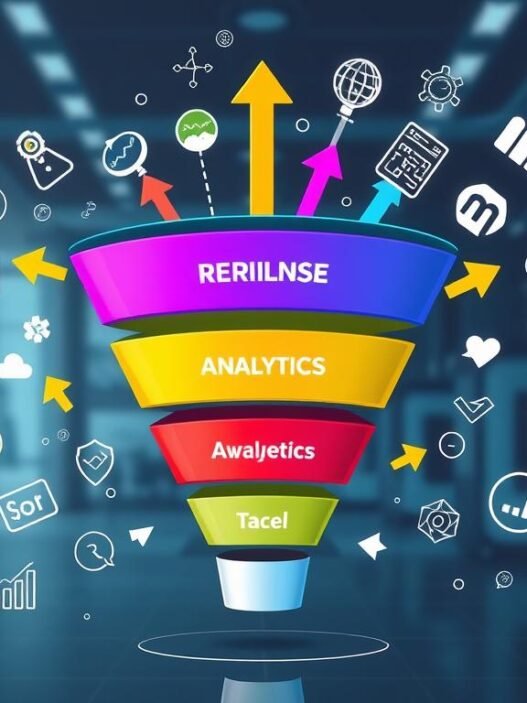Recent studies show that using data-driven decision making (DDDM) can improve decision accuracy by over 70%. This big leap shows how crucial data is in today’s business world1.
In today’s fast world, using data analytics is key. It helps businesses make better choices and adjust quickly to changes. With more information around, using DDDM is essential for staying ahead. It helps companies make smarter, data-backed decisions instead of relying on guesses2.
Using data wisely can make processes smoother and customer experiences better. Those who use data well are ahead of the game. They’re not just following trends; they’re leading the way in innovation and customer happiness3.
Key Takeaways
- Data-driven decision making significantly enhances decision accuracy and reduces uncertainty.
- Firms implementing DDDM can adapt more swiftly to market dynamics.
- Utilizing data analytics leads to deeper insights into customer behavior and operational efficiency.
- Companies stand to gain a competitive advantage by personalizing experiences based on data insights.
- DDDM fosters a culture of innovation and proactive planning within organizations.
The Importance of Data-Driven Decision Making
Data is key for making smart choices in today’s world. Relying on gut feelings can lead to wrong decisions, as many people still trust their instincts over facts4. Moving towards data-driven choices helps organizations tackle tough problems better. Businesses that use data well see their decisions improve by three times4.
With so much data being created every day, there’s a lot to learn from it. This knowledge helps companies succeed4.
Top companies use data tools to make better decisions every day5. CEOs believe data will help them face future challenges like finding workers and fixing supply chains5. This shows how important data is for being open and responsible in business.
The process of using data for decisions has four main steps: collecting data, analyzing it, making choices, and putting those choices into action6. This method makes decisions more accurate and quick. Keeping data reliable is crucial for a company’s long-term success. Leaders who understand what customers want and what’s happening in the market can lead to new ideas and quick responses.
Understanding Data-Driven Decision Making
Data-Driven Decision Making (DDDM) is a method that uses lots of data to guide business plans. It’s key for companies to make clear decisions in today’s complex world. With so much data being created every day, businesses can use it to improve their results7.
For example, big online stores use customer data for better marketing and shopping experiences. This helps them keep an eye on the market and find new customers, boosting sales and engagement7.
Tools like Business Intelligence (BI) software help companies watch their performance closely. Tools like Tableau and Power BI help find important trends in data. This makes it easier for businesses to make smart choices that can really help their profits8.
But, using DDDM comes with its own set of challenges. Issues like bad data quality and trouble integrating different data systems can slow things down. Companies also struggle with relying too much on old data and making decisions based on what they already think9.
The Significance of Transforming Data into Actionable Insights
Turning data into insights is key for today’s businesses. It helps them move from guessing to making smart choices. This change lets them understand the market and meet customer needs better.
Companies that use data well see better results and happier customers. This is important for growing and staying strong.
From Gut Feel to Informed Choices
Before, leaders often made decisions based on feelings. This led to ups and downs and no clear plan. But, now, using data for decisions is a must.
It makes a big difference in how well a business does. Small businesses that use data can see a 6% profit boost10. This helps them know what customers want, making their products better.
Unveiling Patterns and Trends
Data analysis reveals important trends and patterns. It helps businesses understand the market better. Companies that use data insights well can get more customers, keep them, and make more money11.
Even small businesses can use data to improve. For example, DoorDash uses data to work better with vendors. This helps them meet customer needs and cut waste.
Enhancing Predictive Capabilities with Data
Companies are using predictive analytics more to guess future trends and manage risks better. They use advanced analytics and machine learning to forecast needs and spot new risks. It’s expected that global predictive analytics revenues will hit $22 billion by 202612.
This shows how much value data insights have for business strategies in different fields.
The healthcare field shows how important predictive analytics is. It uses patient data to find the best treatments and predict disease risks12. Before the pandemic, patients created about 80MB of data each year. This data is key for better patient care through smarter decisions12.
Data-driven decisions help avoid biases and make choices based on facts13. By analyzing data, companies can find trends and what customers like. This helps them make decisions ahead of time to handle risks13.
Prescriptive analytics even suggests actions based on data. This helps cut costs and improve operations12.
Creating a strong system for collecting, analyzing, and updating data is vital. It makes sure data is accurate and up-to-date. This helps find solutions that work well in changing situations13.
As industries grow, using predictive analytics will be crucial. It helps companies meet market needs and reduce risks.
Optimizing Operational Efficiency through Data Analysis
Today, companies face many challenges to keep their operations running smoothly. Data analysis helps them find and fix problems. This way, they can make big improvements in how they work.
Being able to understand data well is key. It lets businesses see how to make their operations better. This leads to better performance overall.
Identifying Bottlenecks
Finding the slow parts of a process is important for better output. Data analysis helps spot these trouble spots. For example, it can show when machines are down too much, saving money in factories14.
With data insights, companies can see exactly where to make changes. This lets them use their resources better and work more efficiently.
Streamlining Processes
Making operations smoother is crucial for businesses wanting to do better. Switching to better tools, like Python, saved one company 48 hours a month. They also got 13 times more leads15.
Data analysis also helps with managing stock in stores. This ensures they have what customers want when they want it14. It cuts costs and makes customers happier with faster service and products.
Data-Driven Decision Making: Challenges and Solutions
The path to making decisions based on data is filled with hurdles. Companies often struggle with data quality, which hinders their decision-making. High-quality data is key because bad data can lead to wrong conclusions and poor choices. A study found that 43% of companies say poor data quality is the main obstacle to using data for decisions16.
Also, training employees to understand and work with data is vital. This helps them make better use of data insights.
Understanding Data Quality and Integrity
Strong data governance is essential to tackle data issues. It keeps data consistent and reliable across different parts of the business. Companies that focus on data are three times more likely to make better decisions than those that don’t17.
Good data quality leads to more efficient operations and fewer mistakes in important decisions.
Integration of Disparate Data Sources
Combining different data sources is key to getting a full picture of the business. Many companies struggle with this because their data systems are not connected. This makes it hard to analyze everything together.
Recent numbers show that 83% of companies lack the right data management tools, making it tough to use data for decisions16. Creating a single data system can help solve these problems. It lets companies turn their data into useful information.
Another challenge is finding enough people with data and analytics skills. Companies need to address this to improve their ability to analyze data16.
Best Practices for Implementing Data-Driven Decision Making
To make data-driven decisions, you need to follow some key steps. First, set clear goals that match your data efforts with your business aims. This helps guide your data work and leads to better decisions.
Define Clear Objectives
Setting clear goals is key to good data-driven decision-making. Goals should be specific, measurable, achievable, relevant, and timely. This makes your data work clear and focused.
Being open about data helps break down barriers between teams. This makes data more accurate and useful for making smart choices18. When data is reliable, you can make better choices for customers and improve how you run your business19.
A strong data management system is also crucial. It keeps data trustworthy and ensures everyone is accountable. Companies like Amazon and Netflix show how good data use can boost profits and cut costs20. Training your team to use data well is also important19.
- Set specific goals aligned with the organization’s strategic objectives.
- Promote a data-driven culture by encouraging insights sharing among teams.
- Utilize advanced data analytics platforms for real-time reporting and decision support.
- Implement data cleaning processes to improve data quality continuously.
- Establish collaboration channels to reduce errors and enhance decision-making quality.
Following these steps helps your organization use data to make better choices. Tools like Secoda offer a place for easy data analysis. This lets teams find insights that match your goals best practices for data-driven decision making19.
Examples of Successful Data-Driven Decision Making
Many companies have seen big wins by using data to make decisions. For example, Lufthansa boosted its revenue by 30% thanks to advanced analytics21. Google and Amazon also used data to improve their work, with Amazon’s profits going up by 35% and Google’s productivity getting a boost21.
Starbucks used location data to pick the best spots for its stores, which helped its bottom line. A big 62% of retailers said using data helped them stay ahead of the competition22. Netflix looked at lots of viewing data to make better shows and keep customers coming back, showing how data can help attract and keep customers23.
Coca-Cola made ads more personal with social media data, seeing a huge 4x increase in clickthrough rates23. Red Roof Inn targeted ads based on flight data, leading to a 10% increase in check-ins23. These stories show how using data can really help businesses grow and succeed.

Conclusion
In today’s fast-paced world, the future of business relies heavily on a strong data-driven culture. Companies that use data-driven decision-making improve their strategies and gain a big strategic advantage. Studies show that 96% of people believe data is key to making good decisions, showing a shift towards using data in business24.
Businesses that focus on data are more likely to make better decisions, improving by three times25. As markets change, using advanced tech like AI and machine learning can give businesses a competitive edge25.
In summary, companies that keep analyzing data and using insights will lead the way. They will not only outdo their rivals but also grow and innovate with data at the core. For more on data-driven decision making, check out the Terms of Use26.
















